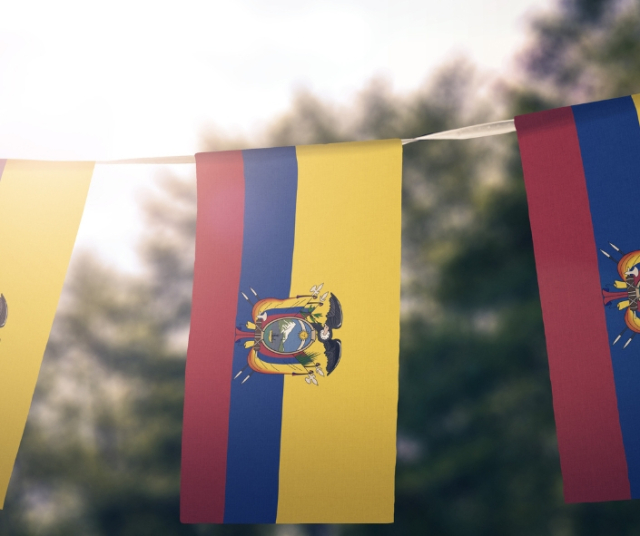September 26 is a special date in Ecuador, since Ecuadorian Flag Day is celebrated. Beyond being a day of formal commemoration, this date symbolizes national identity, the rich and complex history of the country and the bravery of those who fought for its independence. Let's explore the history behind the Ecuadorian Flag, its symbolism, the events that led to its adoption and how this national emblem has come to represent the diversity and unity of the Ecuadorian people.
The History of the Ecuadorian Flag:
The process of creating the Ecuadorian Flag was influenced by the events of independence and the fight against Spanish rule. During the first decades of the 19th century, as the American colonies sought their emancipation, the need for a unifying symbol became evident. The history of the Ecuadorian Flag is intertwined with the birth of the republic and the ideals of freedom that guided the independence leaders.
The first time that the tricolor flag flew in the Ecuadorian sky was on September 26, 1860. It was during the government of President Francisco Robles that the current design of the flag was made official, composed of three horizontal stripes of equal size: yellow on the top, blue in the middle and red at the bottom. In the center of the blue strip is the Coat of Arms of Ecuador, which in turn carries with it a rich symbology.
Symbolism of the Ecuadorian Flag:
Yellow: Yellow represents the wealth and abundance of natural resources in the country. It also symbolizes the light of the sun that illuminates the path to progress and freedom.
Blue: Blue symbolizes the sky that covers Ecuador and the oceans that bathe its coasts. It represents the loyalty and commitment of the Ecuadorian people to the homeland.
Red: Red symbolizes the blood shed by the heroes and martyrs who fought for independence. It represents the courage and bravery of the Ecuadorian people in their search for freedom.
The weapon shield:
In the center of the blue stripe is the Coat of Arms of Ecuador, which adds additional layers of meaning and symbolism to the Ecuadorian Flag. This shield, officially adopted on October 31, 1900, is a heraldic emblem that encapsulates key elements of the country's history and geography.
Mountains and Rivers: In the background of the shield, mountains and rivers are represented that reflect the varied and rich geography of Ecuador. These elements are fundamental to the country's identity and its climatic and ecological diversity.
Radiant Sun: A resplendent sun rises over the landscape, symbolizing freedom and sovereignty. This sun is a reference to Inti, the Inca sun god, and highlights Ecuador's connection to pre-Columbian indigenous cultures.
Ship and Locomotive: A ship and a locomotive represent the modes of transportation that have historically been fundamental to the country's economy. They symbolize Ecuador's connection to trade and modernization.
Laurel and Palm Branches: Laurel and palm branches surround the shield, representing glory and victory. These branches are traditional symbols in heraldry that highlight the triumphs of the Ecuadorian people in their history.
On September 26 Today:
Ecuadorian Flag Day is celebrated with events and ceremonies throughout the country. Educational institutions, civic and government organizations participate in commemorative events that highlight the meaning and importance of the flag as a symbol of national unity.
School Parades:
In many cities and towns, schools organize parades where students march carrying the Ecuadorian Flag. These parades are not only an expression of patriotism, but also an opportunity to educate new generations about the importance of this national emblem.
Official Ceremonies:
In the capital, Quito, and other major cities, official ceremonies are held with the participation of government authorities, the military, and representatives of civil society. These ceremonies typically include flag-raising, patriotic speeches, and artistic performances that highlight the country's cultural richness.
Education and Civic Awareness:
Flag Day is also used as an opportunity to strengthen civic education and national awareness. Schools and government institutions often organize talks, educational activities and contests related to the history and symbolism of the Ecuadorian Flag.
Cultural Celebrations:
In addition to formal activities, September 26 is the occasion for cultural celebrations that highlight the country's diversity. Festivals, gastronomic events and artistic exhibitions are organized to highlight the multiple expressions of Ecuadorian identity.
The gastronomic exhibitions highlight the country's culinary diversity, from the coast to the jungle, offering a delicious sample of Ecuadorian gastronomic wealth.
Folkloric parades are a vibrant manifestation of regional identity, where groups dressed in traditional costumes parade through the streets, preserving and sharing ancestral traditions. These parades are complemented by community events that encourage the active participation of local residents through fairs, games and activities for children.
The day is also an opportunity to honor national heroes, with monuments and historical places that become meeting points to remember their contribution to independence. Audiovisual projections and documentaries explore the history of the country, educating the population about the adoption of the Ecuadorian Flag and the importance of national symbols.
Indigenous communities play a vital role, highlighting their traditions and contributing to cultural diversity. Cultural tourism is promoted through special tours at historical sites, museums and places of cultural interest.
September 26, Ecuadorian Flag Day, goes beyond being a simple commemoration; It is a manifestation of the national identity and the rich and complex history of Ecuador. The Ecuadorian Flag, with its vibrant colors and deep symbolism, stands as a constant reminder of the fight for freedom and unity of the Ecuadorian people. As this day is celebrated, the Ecuadorian Flag flies not only on flagpoles and parades, but in the heart and conscience of each citizen, reminding them of the importance of their legacy and the responsibility to preserve the freedom and diversity it represents.
